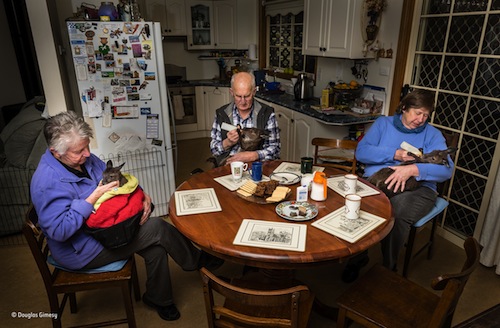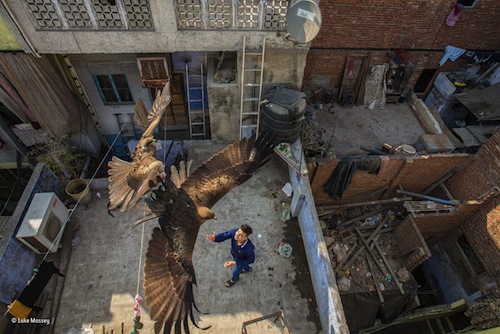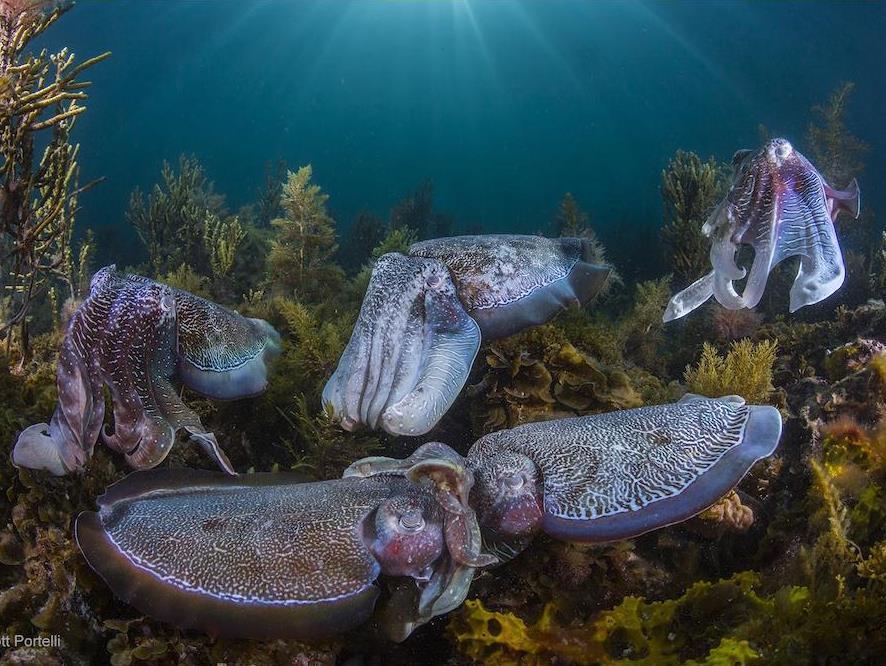Photo: Collective Courtship, Finalist 2016 Wildlife Photographer of the Year Awards: Invertebrates category. By Scott Portelli, Australia. Scott spent hours in the cold shallow waters capturing one of nature’s greatest events, the spawning of giant cuttlefish.
Australian conservation and wildlife photographer Doug Gimesy has spent 30 nights patiently waiting for a fairy penguin at St Kilda Pier. With a clear picture in mind of the photo he wants to capture, he sets his camera up in the perfect position at about 9pm and waits. At 2am he packs up and heads home. The photo hasn’t happened yet, but it will.
From a wild animal in its natural habitat to the domestic life of animals we often share our homes with, wildlife photographers capture moments that take our breath away. While the photos themselves might seem natural, almost effortless, the mastery of the form belies the effort behind each carefully considered shot.
Gimesy describes working as a wildlife photographer as ‘fantastic and bloody frustrating’, where you can take upwards of 10,000 photos in the attempt to get just one right. One of his recent photographs, Caring for Joey (from the series Fast roads, slow deaths) highlights the high tolls which road accidents on Kangaroo Island have on local wildlife.
‘Over 50% of what we see and call “road kill” didn’t actually die straight away, but probably suffered a slow and horrible death after being hit by a vehicle – hence the title of Fast roads, slow deaths,’ said Gimesy.
Caring for Joey is a finalist in the renowned Wildlife Photographer of the Year awards, which you can see at the touring exhibition now showing at the National Wool Museum (NWM) in Geelong until 14 May. The NWM is the only venue in Victoria to host the international exhibition and is the first stop on its Australian tour.

Photo: Caring for Joey, Finalist 2016 The Wildlife Photojournalist Award: Single Image. By Douglas Gimesy, Australia.
‘While we were all sitting around the table having our cake and tea, I looked up and suddenly realised that this was the shot to take, not the one I had planned, so my partner and I jumped up and started taking pictures. If you look closely, you can actually see there are two extra unexplained tea cups on the table.’
2016 Wildlife Photographer of the Year exhibition now on
UK photographer Luke Massey is also a finalist in the 2016 Wildlife Photographer of the Year awards. For his work Kite Flying, Massey travelled to the Muslim quarter of New Delhi, where people toss meat to birds of prey in order to atone for their sins.

Photo: Kite Flying, Finalist 2016 Wildlife Photographer of the Year Award: Urban category. By Luke Massey, UK.
Simon Stafford was the overall winner in the Mammals category for the Wildlife Photographer of the Year 2016 competition for his work, The Aftermath, taken by the Mara River in the Maasai Mara National Reserve, Kenya.
See the award winning wildlife photography in Geelong
‘I had witnessed a very large number of wildebeest crossing the Mara River the previous afternoon; as more and more animals arrived on the far bank of the river they struggled to negotiate the steep incline to reach the top of the bank, and as more and more animals arrived behind those that had already crossed, a stampede took place,’ said Stafford.

Photo: The Aftermath, Winner 2016 Wildlife Photographer of the Year Award: Category Mammals. By Simon Stafford, UK.
‘In the ensuing panic many wildebeest fell and were trampled to death or badly injured to the extent that they could not move out of the way of the following herd. The situation was exacerbated by several Nile crocodiles that were predating the wildebeest, causing panic among them as they swam across the river. Once the herd of wildebeest had finally crossed there was a scene of carnage left behind with many dead and dying animals on the river bank.’
Stafford returned at first light in the hope of capturing a different photo. ‘As I watched the hyena picking their way over the carcasses one broke away and walked to the edge of a ledge on the river bank, and for no more than a couple of seconds it looked straight toward my camera; it was at this moment that I took the photograph.’
Advice from the professionals
Massey’s advice to aspiring wildlife photographers is to be either really good at being bored or really patient. ‘Admire nature; but don’t get too distracted, turn your phone off and don’t fall asleep.’
He also said emerging photographers should start practicing with common, human tolerant species. ‘It means you can revisit them, repeat shots that may not be quite right and try new techniques with no major worries that you may miss that special moment. One of the worst things you can do is start with something rare and hard to photograph. Yes, you might get lucky but nine times out of ten you won’t, you’ll just become disillusioned and demotivated.’
Stafford said preparation is key to wildlife photography, which begins with researching the life cycle of the species. ‘This will provide you with the relevant information of when, where, and how you can go about photographing your subject. Once you arrive at a location speak to people, especially those working with wildlife, such as park rangers, gamekeepers, farmers, etc. Their local knowledge can be priceless in establishing exactly where and when you are likely to find your subject,’ he explained.
‘Once you are on location, observation is vitally important – watch your subject closely and you’ll soon start to understand its behaviour and thus be able to anticipate action. You need to concentrate the whole time, as things can happen very quickly; be prepared to react immediately with your camera. Once you have captured some pictures avoid the temptation to start reviewing them on your camera when your subjects are still present – it’s an almost guaranteed way to miss pictures!’
Visit the National Wool Museum in Geelong to see the Wildlife Photographer of the Year 2016 exhibition, on until 14 May.





